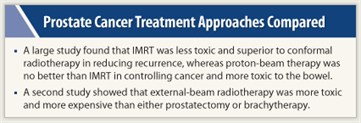 Patients with prostate cancer are treated with various forms of radiotherapy and/or radical prostatectomy with little comparative data to inform treatment selection. Two studies presented at the 2012 Genitourinary Cancers Symposium attempt to address that gap. In one study of men with localized prostate cancer, intensity-modulated radiation therapy (IMRT) proved superior to conformal radiation therapy for prevention of recurrence, with a more favorable side-effect profile. Proton-beam therapy, the most expensive form of radiotherapy, was no better than IMRT.
Patients with prostate cancer are treated with various forms of radiotherapy and/or radical prostatectomy with little comparative data to inform treatment selection. Two studies presented at the 2012 Genitourinary Cancers Symposium attempt to address that gap. In one study of men with localized prostate cancer, intensity-modulated radiation therapy (IMRT) proved superior to conformal radiation therapy for prevention of recurrence, with a more favorable side-effect profile. Proton-beam therapy, the most expensive form of radiotherapy, was no better than IMRT.
A second study found that external-beam radiation therapy was more toxic and two to three times more expensive than either radical prostatectomy or brachytherapy, yet brachytherapy was used much less often.
IMRT has largely supplanted use of the older conformal radiation therapy technique in men with prostate cancer. In 2000, almost 100% of patients with prostate cancer treated with radiation were treated with conformal radiation therapy, but by 2008, almost no patients with prostate cancer who required radiation received conformal radiation therapy, while nearly 100% received IMRT.
 “IMRT has largely replaced conventional conformal radiation therapy as the main radiation technique for prostate cancer without much data to support it. This study validates the change in practice, showing better cancer control and fewer side effects with IMRT vs conformal radiation therapy,” explained senior author Ronald Chen, MD, University of North Carolina, Chapel Hill.1
“IMRT has largely replaced conventional conformal radiation therapy as the main radiation technique for prostate cancer without much data to support it. This study validates the change in practice, showing better cancer control and fewer side effects with IMRT vs conformal radiation therapy,” explained senior author Ronald Chen, MD, University of North Carolina, Chapel Hill.1
The Surveillance, Epidemiology, and End Results (SEER)-Medicare–based study, which included more than 12,000 patients with localized cancer treated with radiation between 2002 and 2007, showed that IMRT was superior to conformal radiation therapy in improving cancer control, as measured by the need for additional cancer treatments: 3.1 per 100 person-years of follow-up for conformal radiation therapy vs 2.5 in the IMRT group (P < .001). IMRT significantly reduced the frequency of bowel side effects from 14.7 to 13.7 per 100 person-years of follow-up (P < .01), although the effects on erectile dysfunction were increased from 5.3 to 5.9 per 100 person-years of follow-up in the IMRT group.
When IMRT was compared with proton-beam therapy, proton-beam therapy was associated with a significant increase in bowel side effects (17.8 per 100 person-years of follow-up vs 12.2 for IMRT; P < .001). No significant difference in cancer control was observed.
“We have seen a rapid growth in the number of proton facilities in the United States over the past 5 years, despite the high cost of this technique. Currently, there is no clear evidence that proton therapy is better than IMRT,” Dr. Chen stated. ”This technology needs to be closely examined through comparative effectiveness research before we adopt it as the ‘next’ treatment for prostate cancer.”
SEER-Medicare Study
 A second study, based on the SEER-Medicare database from 1991 to 2007, found that external-beam radiation therapy was the most toxic and most expensive therapy compared with radical prostatectomy and brachytherapy.2 The study included 137,427 patients diagnosed with prostate cancer at age 65 or older.
A second study, based on the SEER-Medicare database from 1991 to 2007, found that external-beam radiation therapy was the most toxic and most expensive therapy compared with radical prostatectomy and brachytherapy.2 The study included 137,427 patients diagnosed with prostate cancer at age 65 or older.
“Our analysis is one of the first to examine the quality of life and financial cost of these three very common prostate cancer treatment strategies for more than 5 years after treatment,” stated lead author Jay P. Ciezki, MD, of the Cleveland Clinic.
After 15 years of follow-up, the cumulative incidence of genitourinary toxicity was significantly higher for external-beam radiation therapy (approaching 20% of patients) than for prostatectomy (about 7%) or brachytherapy (about 5%; P < .001). The cumulative incidence of gastrointestinal toxicity was also significantly higher with external-beam radiation therapy than for prostatectomy or brachytherapy (P < .0001 for both comparisons), although the overall incidence was under 3% for all groups at 15 years.
The cost per patient-year was $6,412.29 for external-beam radiation therapy, $3,205.71 for prostatectomy, and $2,557.36 for brachytherapy (P < .0001 for all comparisons).
Despite the positive picture for brachytherapy, only about 12% of patients were treated with brachytherapy, while 44% had radical prostatectomy and 44% had external-beam radiation therapy. ■
Disclosure: Dr. Chen reported that his study was funded by the Agency for Healthcare Research and Quality (AHRQ). Dr. Ciezki reported no conflicts of interest.
Expert Point of View: Prostate Cancer Studies Compare Outcomes, Toxicities, and Costs
References
1. Sheets C, Goldin G, Meyer A-M, et al: Comparative effectiveness of intensity modulated radiation therapy, proton therapy, and conformal radiation therapy in the treatment of localized prostate cancer. 2012 Genitourinary Cancers Symposium. Abstract 3. Presented February 2, 2012.
2. Ciezki J, Reddy CA, Angermeier K, et al: A SEER/Medicare database study. 2012 Genitourinary Cancers Symposium. Abstract 4. Presented February 2, 2012.

 Nicholas B. Vogelzang, MD, moderator of the press briefing where these findings were presented, agreed that the first study supports intensity-modulated radiotherapy (IMRT) as the current standard of care. With costs of health care increasing exponentially, it is important to establish the...
Nicholas B. Vogelzang, MD, moderator of the press briefing where these findings were presented, agreed that the first study supports intensity-modulated radiotherapy (IMRT) as the current standard of care. With costs of health care increasing exponentially, it is important to establish the...